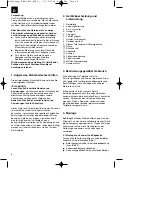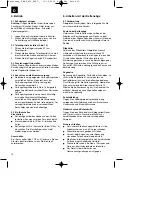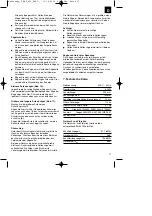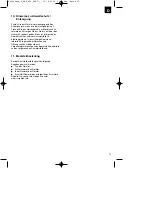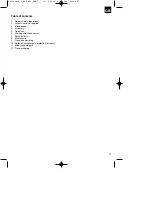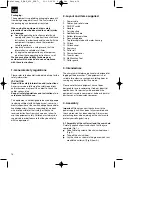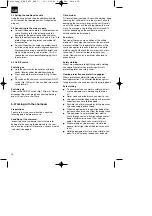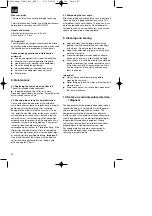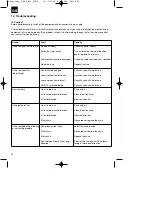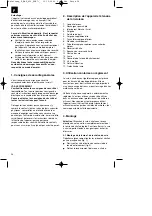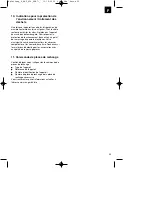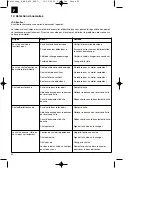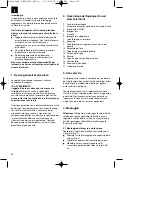
Cutting techniques
When removing branches, hold the equipment at
an angle of max. 60° to the horizontal to avoid
being hit by a falling branch.
Start with the bottom branches on the tree. This
will make it easier for the cut branches to drop.
After completing a cut, the weight of the saw will
abruptly increase for the operator as the saw is
no longer supported by the branch. This can
result in you losing control over the saw.
Remove the saw from the cut only with the saw
chain still running. This will prevent the saw from
getting jammed.
Never cut with the tip of the saw.
Never cut into the bulging branch collar. This will
prevent the tree from healing.
Sawing off smaller branches (Fig. 16):
Place the contact surface of the saw onto the branch.
This will prevent the saw from making jerky
movements when you begin a cut. Exerting slight
pressure, guide the saw from the top to the bottom
through the branch.
Sawing off larger and longer branches (Fig. 17):
Carry out a relief cut when working on larger
branches.
Start by sawing through 1/3 of the branch diameter
(a)
from the bottom to the top with the top side of the
cutter rail. Then saw towards the first cut
(b)
from the
top to the bottom with the bottom side of the cutter
rail.
Saw off longer branches in several steps to keep
control over the impact location.
Kick-back!
The term “kickback” describes what happens when
the running chainsaw suddenly kicks upward and
backward. Usually, this is caused by contact between
the tip of the cutter rail and the workpiece or the saw
chain becoming trapped.
In the event of kickback, large forces occur suddenly
and violently. As a result, the chainsaw usually reacts
uncontrollably. This can often result in very serious
injuries to the worker or persons in the vicinity. The
risk of kickback is at its greatest when the saw is
positioned for a cut in the region of the tip of the cutter
rail, as the leverage effect is greatest there. It is
therefore safest to position the saw as flat as
possible.
Important!
Make sure that the chain tension is always
correctly adjusted.
Only use a chainsaw if it is in perfect working
order.
Only work with a saw chain that has been
properly sharpened in accordance with the
instructions.
Never cut with the upper edge or the tip of the
cutter rail.
Always hold the chainsaw firmly with both hands.
Cutting wood which is under tension
Special care is required when cutting wood which is
under tension. Wood which is under tension from
which it is released by cutting may in some cases
react completely unpredictably and uncontrollably. In
the worst case this could result in extremely severe or
even fatal injuries. This type of work must only be
performed by persons who have been specially
trained.
7. Technical data
Mains voltage:
230 V ~ 50 Hz
Power rating:
600 W
Cutter rail length:
200 mm
Cutting length, max.:
180 mm
Cutting speed at rated rpm:
13 m/s
Oil tank capacity:
110 ml
Weight with cutter rail and chain:
4.1 kg
Chain:
Oregon 90JG-033X, 90SG-033X, 91P033X
Cutter rail:
Oregon 080NATA A041, 084LNEA 041
Protection class:
II /
쏾
Sound and vibration
Sound and vibration values were measured in
accordance with EN 60745.
L
pA
sound pressure level
81.7 dB(A)
K
pA
uncertainty 3
dB
L
WA
sound power level
103 dB(A)
K
WA
uncertainty 3
dB
19
GB
Anleitung_E_EAS_620_SPK7:_ 11.12.2009 9:51 Uhr Seite 19
Summary of Contents for E-EAS 620
Page 5: ...5 11 12 13 14 15 16 K 9 3 G H 7 15 Anleitung_E_EAS_620_SPK7 _ 11 12 2009 9 51 Uhr Seite 5...
Page 6: ...6 17 a b Anleitung_E_EAS_620_SPK7 _ 11 12 2009 9 51 Uhr Seite 6...
Page 83: ...83 Anleitung_E_EAS_620_SPK7 _ 11 12 2009 9 52 Uhr Seite 83...
Page 86: ...86 Anleitung_E_EAS_620_SPK7 _ 11 12 2009 9 52 Uhr Seite 86...




